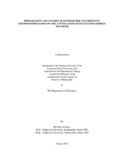Please use this identifier to cite or link to this item:
http://archive.nnl.gov.np:8080/handle/123456789/247Full metadata record
| DC Field | Value | Language |
|---|---|---|
| dc.contributor.author | Acharya, Jiba Raj | |
| dc.date.accessioned | 2017-11-24T07:44:25Z | |
| dc.date.accessioned | 2020-08-21T07:33:57Z | - |
| dc.date.available | 2017-11-24T07:44:25Z | |
| dc.date.available | 2020-08-21T07:33:57Z | - |
| dc.date.issued | 2017-11-24 | |
| dc.identifier.uri | http://103.69.125.248:8080/xmlui/handle/123456789/247 | - |
| dc.description | A Dissertation submitted to the Graduate Faculty of the Louisiana State University and Agricultural and Mechanical College in partial fulfillment of the requirements for the degree of Doctor of Philosophy in the Department of Chemistry | en_US |
| dc.description.abstract | Molecular devices possessing -electron conjugated scaffold demonstrate unique capabilities as fluorescent chemosensors for the trace detection of analytes in a variety of environments. Important properties of these compounds such as charge transport and exciton migration, emission intensity etc. can be simply attenuated by external stimuli or analyte binding, leading to considerable changes in observable signals. The main goal of this Ph.D. dissertation was to study the possibility to control excitation energy migration in conjugated systems. Towards this goal, we designed surface-immobilized monodispersed oligo(p-phenylene ethynylene)s (OPEs) as a general basis for thin-film ratiometric fluorescent chemosensors. The sensor molecules have been functionalized with a specific analyte receptor at one end and a linkage for the covalent attachment to a glass surface at the opposite end. Upon surface immobilization these sensor molecules form a highly ordered monolayer with the receptors positioned at the monolayer surface. Analyte binding to the receptor causes attenuation of the HOMO–LUMO gap at the receptor terminus leading to the ratiometric change in fluorescent emission. The thin-film sensors for L-cysteine, pH and Zn2+ were prepared and studied in detail to uncover a number of unusual properties, thus demonstrating the potential of this platform as a universal foundation for designing a broad range of fluorescent ratiometric thin-film chemosensors. | en_US |
| dc.language.iso | en | en_US |
| dc.subject | Fluorescent chemosensors | en_US |
| dc.subject | Ratiometric fluorescent | en_US |
| dc.title | Preparation and studies of ratiometric fluorescent chemosenors based on the attenuation of excitation energy transfer | en_US |
| dc.type | Thesis | en_US |
| Appears in Collections: | 500 Natural sciences and mathematics | |
Files in This Item:
| File | Description | Size | Format | |
|---|---|---|---|---|
| Acharya_diss.pdf | 9.15 MB | Adobe PDF |  View/Open |
Items in DSpace are protected by copyright, with all rights reserved, unless otherwise indicated.